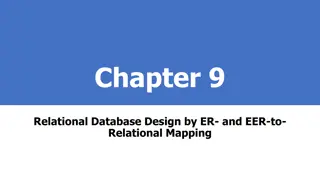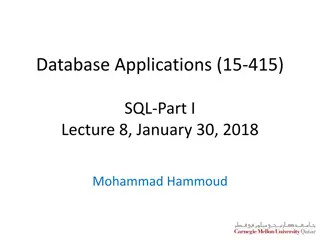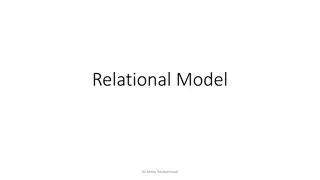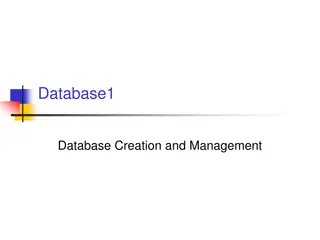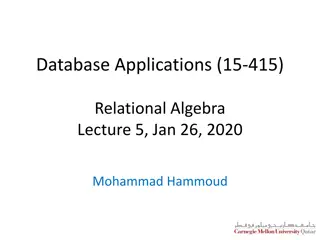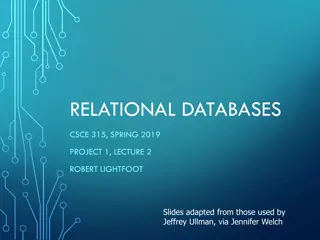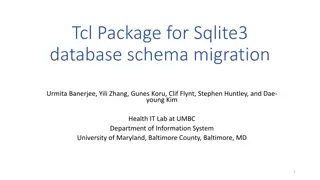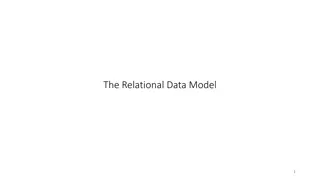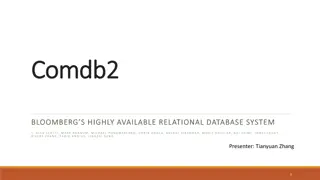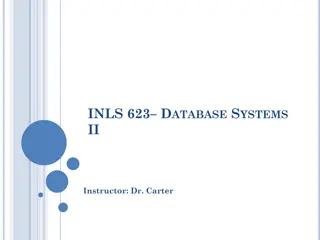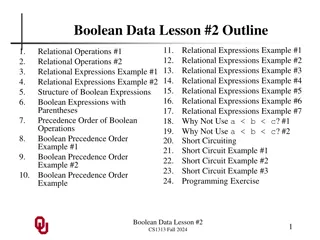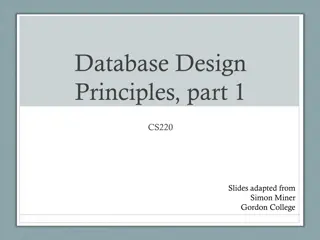Understanding Relational Database Design Fundamentals
This content delves into the crucial aspects of relational database design, including normalization, pitfalls, RDBMS design issues, and the overall database design process. It emphasizes the need for well-structured relation schemas to minimize redundancy, ensure data integrity, and facilitate efficient database management. Through formal measures like normalization, designers aim to optimize database structures and reduce anomalies effectively.
Download Presentation

Please find below an Image/Link to download the presentation.
The content on the website is provided AS IS for your information and personal use only. It may not be sold, licensed, or shared on other websites without obtaining consent from the author. Download presentation by click this link. If you encounter any issues during the download, it is possible that the publisher has removed the file from their server.
E N D
Presentation Transcript
Relational Database Design Presented By Dr. Monika Patel Asst. Professor Computer Dept Durga Mahavidyalaya Raipur(CG) 1
Relational Database Design RDBMS design issues Pitfalls and Normalization. First Normal Form Pitfalls in Relational Database Design Functional Dependencies Decomposition Boyce-Codd Normal Form Third Normal Form Multivalued Dependencies and Fourth Normal Form Overall Database Design Process 2
RDBMS Design issues Each relation schema consists of a number of attributes and the relational database schema consists of a number of relation schemas. Ex. Relation Lending-schema = (branch-name, branch-city, assets, customer-name, loan-number, amount) So far we have assumed that attributes are grouped to form a relation schema by using the common sense of database designer or by mapping a schema defined by ER model. We still need some formal measure of why one grouping of attributes into a relation schema may be better than another. In general, the goal of schema design is to reduce various anomalies. schema: 3
Pitfalls in Relational Database Design Relational database design requires that we find a good collection of relation schemas. A bad design may lead to Repetition of Information. Inability to represent certain information. Design Goals: Avoid redundant data Ensure that relationships among attributes are represented Facilitate the checking of updates for violation of database integrity constraints. 4
Normalization The basic objective of normalization is to reduce the various anomalies in the database. Normalization can be looked upon as a process of analyzing the given relation schemas based on their FDs and primary keys to achieve the desirable properties of ; Minimizing redundancy Minimizing the insertion, deletion, and update anomalies. Unsatisfactory relation schemas that do not meet certain conditions the normal form tests are decomposed into smaller relation schemas that meet the tests and hence possess the desirable properties. Thus, the normalization procedure provides database designers with; A formal framework for analyzing relation schemas based on their keys and on the functional dependencies among their attributes. A series of normal form tests that can be carried out on individual relation schemas so that the relational database can be normalized to any desired degree. 5
Normalization The normal form of a relation refers to the highest normal form condition that it meets, and hence indicates the degree to which it has been normalized. Normal forms when considered in isolation from other factors, do not guarantee a good database design. It is generally not sufficient to check separately that each relation schema in the database is, say, in BCNF or 3NF. Rather, the process of decomposition must also confirm the existence of additional properties that the relation schemas, taken together should possess; The Lossless join, The dependency preservation property, which ensures that each functional dependency is represented in some individual relations resulting after decomposition. normalization through 6
First Normal Form Domain is atomic if its elements are considered to be indivisible units Examples of non-atomic domains: Set of names, composite attributes Identification numbers like CS101 that can be broken up into parts A relational schema R is in first normal form if the domains of all attributes of R are atomic Non-atomic values complicate storage and encourage redundant (repeated) storage of data E.g. Set of accounts stored with each customer, and set of owners stored with each account We assume all relations are in first normal form (revisit this in Chapter 9 on Object Relational Databases) 7
Example Consider the relation schema: Lending-schema = (branch-name, branch-city, assets, customer-name, loan-number, amount) Redundancy: Data for branch-name, branch-city, assets are repeated for each loan that a branch makes Wastes space Complicates updating, introducing possibility of inconsistency of assets value Null values Cannot store information about a branch if no loans exist Can use null values, but they are difficult to handle. 8
Decomposition Decompose the relation schema Lending-schema into: Branch-schema = (branch-name, branch-city,assets) Loan-info-schema = (customer-name, loan-number, branch-name, amount) All attributes of an original schema (R) must appear in the decomposition (R1, R2): R = R1 R2 Lossless-join decomposition. For all possible relations r on schema R r = R1 (r) R2 (r) 9
Example of Non Lossless-Join Decomposition Decomposition of R = (A, B) R2 = (A) R2 = (B) A B A B 1 2 B(r) 1 2 1 A(r) r A B A (r) B (r) 1 2 1 2 10
Goal Devise a Theory for the Following Decide whether a particular relation R is in good form. In the case that a relation Ris not in good form, decompose it into a set of relations {R1, R2, ..., Rn} such that each relation is in good form the decomposition is a lossless-join decomposition Our theory is based on: functional dependencies multivalued dependencies. 11
Functional Dependencies (Cont.) Let R be a relation schema R and R The functional dependency holds on R if and only if for any legal relations r(R), whenever any two tuples t1and t2 of r agree on the attributes , they also agree on the attributes . That is, t1[ ] = t2 [ ] t1[ ] = t2 [ ] Example: Consider r(A,B) with the following instance of r. 1 1 5 4 On this instance, A B does NOT hold, but B A does hold. 3 7 12
Functional Dependencies (Cont.) K is a superkey for relation schema R if and only if K R K is a candidate key for R if and only if K R, and for no K, R Functional dependencies allow us to express constraints that cannot be expressed using superkeys. Consider the schema: Loan-info-schema = (customer-name, loan-number, branch-name, amount). We expect this set of functional dependencies to hold: loan-number amount loan-number branch-name but would not expect the following to hold: loan-number customer-name 13
Use of Functional Dependencies We use functional dependencies to: test relations to see if they are legal under a given set of functional dependencies. If a relation r is legal under a set F of functional dependencies, we say that r satisfies F. specify constraints on the set of legal relations We say that F holds on R if all legal relations on R satisfy the set of functional dependencies F. Note: A specific instance of a relation schema may satisfy a functional dependency even if the functional dependency does not hold on all legal instances. For example, a specific instance of Loan-schema may, by chance, satisfy loan-number customer-name. 14
Functional Dependencies (Cont.) A functional dependency is trivial if it is satisfied by all instances of a relation E.g. customer-name, loan-number customer-name customer-name customer-name In general, is trivial if 15
Closure of a Set of Functional Dependencies Given a set F set of functional dependencies, there are certain other functional dependencies that are logically implied by F. E.g. If A B and B C, then we can infer that A C The set of all functional dependencies logically implied by F is the closure of F. We denote the closure of F by F+. We can find all ofF+by applying Armstrong s Axioms: if , then (reflexivity) if , then (augmentation) if , and , then (transitivity) These rules are sound (generate only functional dependencies that actually hold) and complete (generate all functional dependencies that hold). 16
Example R = (A, B, C, G, H, I) F = { A B A C CG H CG I B H} some members of F+ A H by transitivity from A B and B H AG I by augmenting A C with G, to get AG CG and then transitivity with CG I CG HI from CG H and CG I : union rule can be inferred from definition of functional dependencies, or Augmentation of CG I to infer CG CGI, augmentation of CG H to infer CGI HI, and then transitivity 17
Procedure for Computing F+ To compute the closure of a set of functional dependencies F: F+ = F repeat until F+ does not change any further for each functional dependency f in F+ apply reflexivity and augmentation rules on f add the resulting functional dependencies to F+ for each pair of functional dependencies f1and f2 in F+ iff1 and f2 can be combined using transitivity then add the resulting functional dependency to F+ NOTE: We will see an alternative procedure for this task later 18
Closure of Functional Dependencies (Cont.) We can further simplify manual computation of F+ by using the following additional rules. If holds and holds, then holds (union) If holds, then holds and holds (decomposition) If holds and holds, then holds (pseudotransitivity) The above rules can be inferred from Armstrong s axioms. 19
Closure of Attribute Sets Given a set of attributes define the closure of under F (denoted by +) as the set of attributes that are functionally determined by under F: is in F+ + Algorithm to compute +, the closure of under F result := ; while (changes to result) do for each in F do begin if result then result := result end 20
Example of Attribute Set Closure R = (A, B, C, G, H, I) F = {A B A C CG H CG I B H} (AG)+ 1. result = AG 2. result = ABCG (A C and A B) 3. result = ABCGH (CG H and CG AGBC) 4. result = ABCGHI (CG I and CG AGBCH) Is AG a candidate key? 1. Is AG a super key? 1. Does AG R? 2. Is any subset of AG a superkey? 1. Does A+ R? 2. Does G+ R? 21
Uses of Attribute Closure There are several uses of the attribute closure algorithm: Testing for superkey: To test if is a superkey, we compute +, and check if + contains all attributes of R. Testing functional dependencies To check if a functional dependency holds (or, in other words, is in F+), just check if +. That is, we compute + by using attribute closure, and then check if it contains . Is a simple and cheap test, and very useful Computing closure of F For each R, we find the closure +, and for each S +, we output a functional dependency S. 22
Canonical Cover Sets of functional dependencies may have redundant dependencies that can be inferred from the others Eg: A C is redundant in: {A B, B C, A C} Parts of a functional dependency may be redundant E.g. on RHS: {A B, B C, A CD} can be simplified to {A B, B C, A D} E.g. on LHS: {A B, B C, AC D} can be simplified to {A B, B C, A D} Intuitively, a canonical cover of F is a minimal set of functional dependencies equivalent to F, with no redundant dependencies or having redundant parts of dependencies 23
Extraneous Attributes Consider a set F of functional dependencies and the functional dependency in F. Attribute A is extraneous in if A and F logically implies (F { }) {( A) }. Attribute A is extraneous in if A and the set of functional dependencies (F { }) { ( A)} logically implies F. Note: implication in the opposite direction is trivial in each of the cases above, since a stronger functional dependency always implies a weaker one Example: Given F = {A C, AB C } B is extraneous in AB C because A C logically implies AB C. Example: Given F = {A C, AB CD} C is extraneous in AB CD since A C can be inferred even after deleting C 24
Testing if an Attribute is Extraneous Consider a set F of functional dependencies and the functional dependency in F. To test if attribute A is extraneous in 1. compute (A { })+ using the dependencies in F 2. check that (A { })+ contains ; if it does, A is extraneous To test if attribute A is extraneous in 1. compute + using only the dependencies in F = (F { }) { ( A)}, 2. check that + contains A; if it does, A is extraneous 25
Canonical Cover A canonical cover for F is a set of dependencies Fc such that F logically implies all dependencies in Fc, and Fclogically implies all dependencies in F, and No functional dependency in Fc contains an extraneous attribute, and Each left side of functional dependency in Fcis unique. To compute a canonical cover for F: repeat Use the union rule to replace any dependencies in F 1 1 and 1 1 with 1 1 2 Find a functional dependency with an extraneous attribute either in or in If an extraneous attribute is found, delete it from until F does not change Note: Union rule may become applicable after some extraneous attributes have been deleted, so it has to be re-applied 26
Example of Computing a Canonical Cover R = (A, B, C) F = {A BC B C A B AB C} Combine A BC and A B into A BC Set is now {A BC, B C, AB C} A is extraneous in AB C because B C logically implies AB C. Set is now {A BC, B C} C is extraneous in A BC since A BC is logically implied by A B and B C. The canonical cover is: A B B C 27
Goals of Normalization Decide whether a particular relation Ris in good form. In the case that a relation Ris not in good form, decompose it into a set of relations {R1, R2, ..., Rn} such that each relation is in good form the decomposition is a lossless-join decomposition Our theory is based on: functional dependencies multivalued dependencies 28
Decomposition Decompose the relation schema Lending-schema into: Branch-schema = (branch-name, branch-city,assets) Loan-info-schema = (customer-name, loan-number, branch-name, amount) All attributes of an original schema (R) must appear in the decomposition (R1, R2): R = R1 R2 Lossless-join decomposition. For all possible relations r on schema R r = R1 (r) R2 (r) A decomposition of R into R1 and R2 is lossless join if and only if at least one of the following dependencies is in F+: R1 R2 R1 R1 R2 R2 29
Example of Lossy-Join Decomposition Lossy-join decompositions result in information loss. Example: Decomposition of R = (A, B) R1 = (A) R2 = (B) A B A B 1 2 B(r) 1 2 1 A(r) r A B A (r) B (r) 1 2 1 2 30
Normalization Using Functional Dependencies When we decompose a relation schema R with a set of functional dependencies F into R1, R2,.., Rn we want Lossless-join decomposition: Otherwise decomposition would result in information loss. No redundancy: The relations Ripreferably should be in either Boyce-Codd Normal Form or Third Normal Form. Dependency preservation: Let Fibe the set of dependencies F+ that include only attributes in Ri. Preferably the decomposition should be dependency preserving, that is, (F1 F2 Fn)+ = F+ Otherwise, checking updates for violation of functional dependencies may require computing joins, which is expensive. 31
Example R = (A, B, C) F = {A B, B C) R1 = (A, B), R2 = (B, C) Lossless-join decomposition: Dependency preserving R1 = (A, B), R2 = (A, C) Lossless-join decomposition: Not dependency preserving (cannot check B C without computing R1 R1 R2 = {B} and B BC R1 R2 = {A} and A AB R2) 32
Testing for Dependency Preservation To check if a dependency is preserved in a decomposition of R into R1, R2, , Rn we apply the following simplified test (with attribute closure done w.r.t. F) result = while (changes to result) do for eachRiin the decomposition t = (result Ri)+ Ri result = result t If result contains all attributes in , then the functional dependency is preserved. We apply the test on all dependencies in F to check if a decomposition is dependency preserving This procedure takes polynomial time, instead of the exponential time required to compute F+and(F1 F2 Fn)+ 33
Boyce-Codd Normal Form A relation schema R is in BCNF with respect to a set F of functional dependencies if for all functional dependencies in F+ of the form , where R and R,at least one of the following holds: is trivial (i.e., ) is a superkey for R 34
Example R = (A, B, C) F = {A B B C} Key = {A} R is not in BCNF Decomposition R1 = (A, B), R2 = (B, C) R1and R2 in BCNF Lossless-join decomposition Dependency preserving 35
Testing for BCNF To check if a non-trivial dependency causes a violation of BCNF 1. compute + (the attribute closure of ), and 2. verify that it includes all attributes of R, that is, it is a superkey of R. Simplified test: To check if a relation schema R with a given set of functional dependencies F is in BCNF, it suffices to check only the dependencies in the given set F for violation of BCNF, rather than checking all dependencies in F+. We can show that if none of the dependencies in F causes a violation of BCNF, then none of the dependencies in F+ will cause a violation of BCNF either. However, using only F is incorrect when testing a relation in a decomposition of R E.g. Consider R (A, B, C, D), with F = { A B, B C} Decompose R into R1(A,B) and R2(A,C,D) Neither of the dependencies in F contain only attributes from (A,C,D) so we might be mislead into thinking R2 satisfies BCNF. In fact, dependency A C in F+ shows R2 is not in BCNF. 36
BCNF Decomposition Algorithm result := {R}; done := false; compute F+; while (not done) do if (there is a schema Riin result that is not in BCNF) then begin let be a nontrivial functional dependency that holds on Ri such that Riis not in F+, and = ; result := (result Ri) (Ri ) ( , ); end else done := true; Note: each Riis in BCNF, and decomposition is lossless-join. 37
Example of BCNF Decomposition R = (branch-name, branch-city, assets, customer-name, loan-number, amount) F = {branch-name assets branch-city loan-number amount branch-name} Key = {loan-number, customer-name} Decomposition R1 = (branch-name, branch-city, assets) R2 = (branch-name, customer-name, loan-number, amount) R3 = (branch-name, loan-number, amount) R4 = (customer-name, loan-number) Final decomposition R1, R3, R4 38
Testing Decomposition for BCNF To check if a relation Ri in a decomposition of R is in BCNF, Either test Ri for BCNF with respect to the restriction of F to Ri (that is, all FDs in F+ that contain only attributes from Ri) or use the original set of dependencies F that hold on R, but with the following test: for every set of attributes Ri, check that + (the attribute closure of ) either includes no attribute of Ri- , or includes all attributes of Ri. If the condition is violated by some in F, the dependency ( + - ) Ri can be shown to hold on Ri, and Ri violates BCNF. We use above dependency to decompose Ri 39
BCNF and Dependency Preservation It is not always possible to get a BCNF decomposition that is dependency preserving R = (J, K, L) F = {JK L L K} Two candidate keys = JK and JL R is not in BCNF Any decomposition of R will fail to preserve JK L 40
Third Normal Form: Motivation There are some situations where BCNF is not dependency preserving, and efficient checking for FD violation on updates is important Solution: define a weaker normal form, called Third Normal Form. Allows some redundancy (with resultant problems; we will see examples later) But FDs can be checked on individual relations without computing a join. There is always a lossless-join, dependency-preserving decomposition into 3NF. 41
Third Normal Form A relation schema R is in third normal form (3NF) if for all: in F+ at least one of the following holds: is trivial (i.e., ) is a superkey for R Each attribute A in is contained in a candidate key for R. (NOTE: each attribute may be in a different candidate key) If a relation is in BCNF it is in 3NF (since in BCNF one of the first two conditions above must hold). Third condition is a minimal relaxation of BCNF to ensure dependency preservation (will see why later). 42
3NF (Cont.) Example R = (J, K, L) F = {JK L, L K} Two candidate keys: JK and JL R is in 3NF JK L L K BCNF decomposition has (JL) and (LK) Testing for JK L requires a join There is some redundancy in this schema Equivalent to example in book: Banker-schema = (branch-name, customer-name, banker-name) banker-name branch name branch name customer-name banker-name JK is a superkey K is contained in a candidate key 43
Testing for 3NF Optimization: Need to check only FDs in F, need not check all FDs in F+. Use attribute closure to check, for each dependency , if is a superkey. If is not a superkey, we have to verify if each attribute in is contained in a candidate key of R this test is rather more expensive, since it involve finding candidate keys testing for 3NF has been shown to be NP-hard Interestingly, decomposition into third normal form (described shortly) can be done in polynomial time 44
3NF Decomposition Algorithm Let Fcbe a canonical cover for F; i := 0; for each functional dependency in Fcdo if none of the schemas Rj, 1 j i contains then begin i := i + 1; Ri := end if none of the schemas Rj, 1 j i contains a candidate key for R then begin i := i + 1; Ri := any candidate key for R; end return (R1, R2, ..., Ri) 45
3NF Decomposition Algorithm (Cont.) Above algorithm ensures: each relation schema Riis in 3NF decomposition is dependency preserving and lossless-join Proof of correctness is at end of this file (click here) 46
Example Relation schema: Banker-info-schema = (branch-name, customer-name, The functional dependencies for this relation schema are: banker-name branch-name office- number customer-name branch-name banker- name The key is: {customer-name, branch-name} banker-name, office-number) 47
Applying 3NF to Banker-info-schema The for loop in the algorithm causes us to include the following schemas in our decomposition: Banker-office-schema = (banker-name, branch- name, Banker-schema = (customer-name, branch- name, banker-name) office-number) Since Banker-schema contains a candidate key for Banker-info-schema, we are done with the decomposition process. 48
Comparison of BCNF and 3NF It is always possible to decompose a relation into relations in 3NF and the decomposition is lossless the dependencies are preserved It is always possible to decompose a relation into relations in BCNF and the decomposition is lossless it may not be possible to preserve dependencies. 49
Comparison of BCNF and 3NF (Cont.) Example of problems due to redundancy in 3NF R = (J, K, L) F = {JK L, L K} J L K j1 l1 l1 l1 k1 k1 k1 j2 j3 l2 k2 null A schema that is in 3NF but not in BCNF has the problems of repetition of information (e.g., the relationship l1, k1) need to use null values (e.g., to represent the relationship l2, k2 where there is no corresponding value for J). 50



